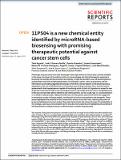Por favor, use este identificador para citar o enlazar a este item:
http://hdl.handle.net/10261/188732COMPARTIR / EXPORTAR:
 SHARE SHARE
 CORE
BASE CORE
BASE
|
|
| Visualizar otros formatos: MARC | Dublin Core | RDF | ORE | MODS | METS | DIDL | DATACITE | |

| Título: | 11PS04 is a new chemical entity identified by microRNA-based biosensing with promising therapeutic potential against cancer stem cells |
Autor: | Aguado, Tania CSIC ORCID; Romero-Revilla, José A. CSIC; Granados, R.; Campuzano, Susana CSIC ORCID; Torrente-Rodríguez, Rebeca M.; Cuesta, Ángel M. CSIC ORCID ; Albiñana, Virginia CSIC; Botella, Luisa María CSIC ORCID ; Santamaría, Silvia CSIC ORCID; García-Sanz, José A. CSIC ORCID ; Pingarrón, José Manuel; Sánchez-Sancho, Francisco CSIC; Sánchez-Puelles, José María CSIC ORCID | Fecha de publicación: | 15-ago-2019 | Editor: | Springer Nature | Citación: | Sci Rep 9 (1) 11916 (2019) | Resumen: | Phenotypic drug discovery must take advantage of the large amount of clinical data currently available. In this sense, the impact of microRNAs (miRs) on human disease and clinical therapeutic responses is becoming increasingly well documented. Accordingly, it might be possible to use miR-based signatures as phenotypic read-outs of pathological status, for example in cancer. Here, we propose to use the information accumulating regarding the biology of miRs from clinical research in the preclinical arena, adapting it to the use of miR biosensors in the earliest steps of drug screening. Thus, we have used an amperometric dual magnetosensor capable of monitoring a miR-21/miR-205 signature to screen for new drugs that restore these miRs to non-tumorigenic levels in cell models of breast cancer and glioblastoma. In this way we have been able to identify a new chemical entity, 11PS04 ((3aR,7aS)-2-(3-propoxyphenyl)-7,7a-dihydro-3aH-pyrano[3,4-d]oxazol-6(4H)-one), the therapeutic potential of which was suggested in mechanistic assays of disease models, including 3D cell culture (oncospheres) and xenografts. These assays highlighted the potential of this compound to attack cancer stem cells, reducing the growth of breast and glioblastoma tumors in vivo. These data demonstrate the enhanced chain of translatability of this strategy, opening up new perspectives for drug-discovery pipelines and highlighting the potential of miR-based electro-analytical sensors as efficient tools in modern drug discovery. | Descripción: | 13 p.-5 fig-1 tab. | Versión del editor: | https://doi.org/10.1038/s41598-019-48359-y | URI: | http://hdl.handle.net/10261/188732 | DOI: | 10.1038/s41598-019-48359-y | E-ISSN: | 2045-2322 |
| Aparece en las colecciones: | (CIB) Artículos (IQM) Artículos |
Ficheros en este ítem:
| Fichero | Descripción | Tamaño | Formato | |
|---|---|---|---|---|
| Scientific Reports_Aguado_2019.pdf | Artículo principal | 3,06 MB | Adobe PDF |  Visualizar/Abrir |
CORE Recommender
PubMed Central
Citations
1
checked on 22-abr-2024
SCOPUSTM
Citations
2
checked on 23-abr-2024
WEB OF SCIENCETM
Citations
2
checked on 24-feb-2024
Page view(s)
237
checked on 23-abr-2024
Download(s)
121
checked on 23-abr-2024

